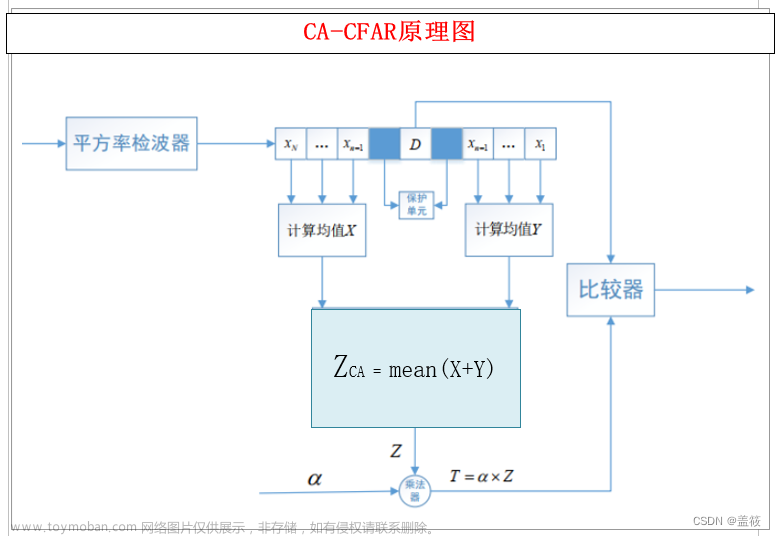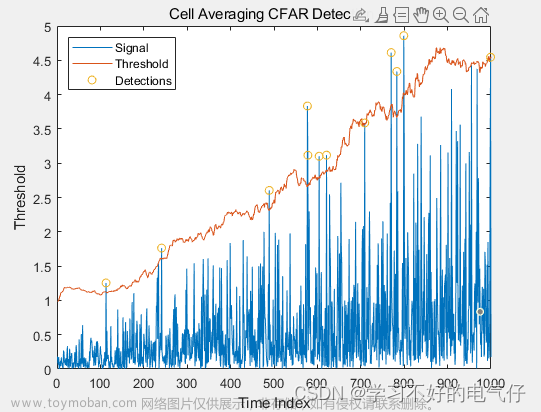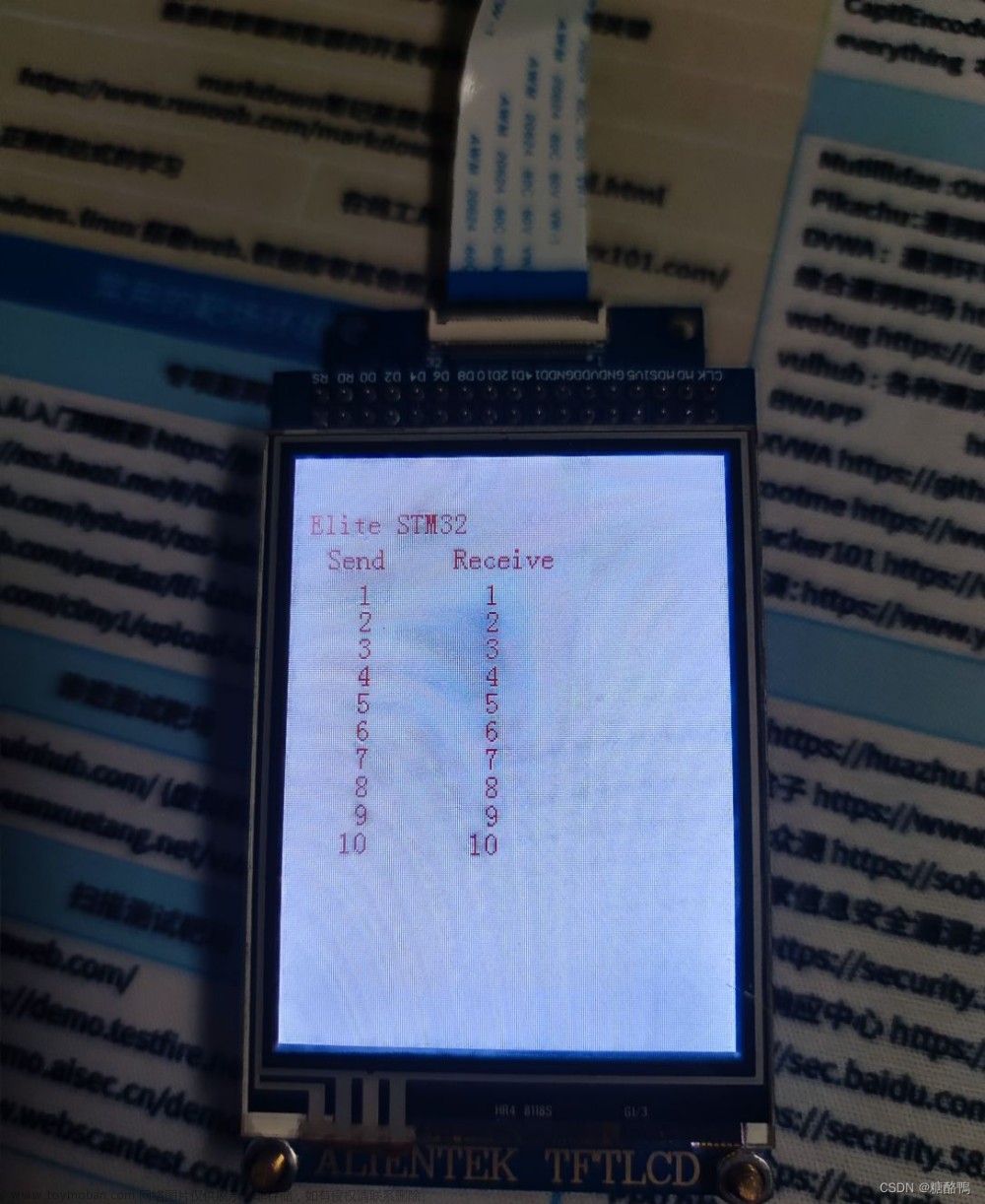function sar_cfar_6(hObject,eventdata,handles,f)
%SAR图像CFAR目标检测算法,算法采用的是基于瑞利分布的双参数CFAR算法
% sar_cfar_4(hObject,eventdata,handles,f),hObject,eventdata,handles分别是
% 图形界面程序传递下来的对象,事件,句柄;在这里,对象和事件均未使用,只使用了
% 句柄,f为输入的SAR图像,此时,SAR图像已经由三维变成了一维
f=imread('G:\1.jpg');%导入自己的图片,记得修改图片路径
figure;
imshow(f);
pf = 0.05; %人为设定的恒虚警率
% densGate = 0.01; %密度滤波阈值
% rad = 1; %形态学滤波结构元素半径值
%--图像前期处理
f = double(f);
f_size = size(f);
%--交互的确定目标尺寸
% rect = getrect(handles.axes1);
width = 5;
height = 10;
% tic
%--进度条程序
% hWaitbar = waitbar(0,'请等待');
% h1=findobj(hWaitbar,'type','patch');
% set(h1,'FaceColor','r','EdgeColor','y');
% numWait = f_size(1)*f_size(2);
% numWaitCount = 0;
%--------------------------------------------------------------------------
% 一、确定CFAR检测器参数,包括窗口尺寸,保护区宽度,杂波区宽度
%--------------------------------------------------------------------------
%--确定CFAR检测器的参数
%--1.取长宽中的最大值
global tMaxLength;
tMaxLength = max(width,height);
%--2.确定保护区的边长
global proLength;
proLength = tMaxLength*2 + 1; %为方便计算,取为奇数
%--3.确定杂波区环形宽度
global cLength;
cLength = 1; %厚度一般为1个像素点
%--4.计算用于杂波区域的像素数
numPix = 2*cLength*(2*cLength+proLength+proLength);
%--5.CFAR检测器边长的一半
global cfarHalfLength;
cfarHalfLength = tMaxLength+cLength;
%--6.CFAR检测器边长
global cfarLength;
cfarLength = proLength + 2*cLength;
str = sprintf('CFAR检测器保护区边长:%f,杂波区环形宽度:%f,用于杂波的像素数:%f'...
,proLength,cLength,numPix); %显示
% disp(str); %显示
%--------------------------------------------------------------------------
% 二、对原图像边界扩充,以消除边界的影响
%--------------------------------------------------------------------------
padLength = cfarHalfLength; %确定图像填充的边界大小为CFAR滑窗的一半
global g;
g = padarray(f,[padLength padLength],'symmetric'); %g为填充后的图像
% global g_dis; %画图
% g_dis = g; %画图
%--------------------------------------------------------------------------
% 三、确定CFAR阈值
%--------------------------------------------------------------------------
th = (2*sqrt(-log(pf))-sqrt(pi))/(sqrt(4-pi)); %该阈值由认为确定的虚警概率求
%得
%--------------------------------------------------------------------------
% 四、利用CFAR检测器,求解局部阈值,执行单个像素点的判断
%--------------------------------------------------------------------------
%--1.定义结果处理矩阵
global resultArray
resultArray = zeros(size(g));
%--2.CFAR检测
%这里将CFAR检测器划分为四个检测区,如下图所示
%
% |—————————————|
% |——————-1——————|
% | | | |
% | | | |
% | 3 | | 4 |
% | | | |
% | | | |
% | | | |
% |—————————————|
% |——————-2——————|
%遍历图像中的每个点
for i = (1+padLength):(f_size(1)+padLength)
for j = (1+padLength):(f_size(2)+padLength)
[csIndex1 csIndex2 csIndex3 csIndex4] = getEstSec(i,j,1);
%得到(i,j)处像素所对应的4个杂波估计区域,如上图所示
[u,delta] = cfarEstPra(csIndex1,csIndex2,csIndex3,csIndex4);
%由杂波区域得到均值和标准偏差
temp = (g(i,j)-u)/delta; %计算双参数CFAR检测判别式
%目标点判别
if temp > th
resultArray(i,j) = 255;
else resultArray(i,j) = 0;
end
end
end
figure;
imshow(resultArray);
%--------------------------------------------------------------------------
% 五、目标像素聚类
%--------------------------------------------------------------------------
%--1.密度滤波
% [row col] = find(resultArray == 1); %找到目标像素点的行列坐标
% numIndex2 = numel(row); %确定目标点个数
% resultArray2 = zeros(size(g)); %resultArray2用以存放密度滤波后的矩阵
% for k = 1:numIndex2 %执行密度滤波
% resultArray2(row(k),col(k)) = densfilt(row(k),col(k),width,height,...
% densGate);
% end
%--2.形态学滤波
se = strel('disk',1);
resultArray2 = imclose(resultArray,se); %闭运算
se = strel('disk',1);
resultArray3 = imerode(resultArray2,se); %腐蚀
resultArray4 = imdilate(resultArray3,se);
% waitbar(1,hWaitbar,'算法完毕');
% close(hWaitbar);
% toc
% t = toc; %计算算法时间
figure;
imshow(resultArray3);
figure;
imshow(resultArray4);
%--3.展示结果图片
% resultArray = resultArray((padLength+1):(end-padLength),(padLength+1):(end-padLength));
% figure('Name','CFAR检测后二值图'),imshow(resultArray);
% resultArray2 = resultArray2((padLength+1):(end-padLength),(padLength+1):(end-padLength));
% figure('Name','密度滤波后二值图'),imshow(resultArray2);
% resultArray3 = resultArray3((padLength+1):(end-padLength),(padLength+1):(end-padLength));
% figure('Name','形态滤波后二值图'),imshow(resultArray3);
%--------------------------------------------------------------------------
% 本算法中用到的函数
%--------------------------------------------------------------------------
%------------一、密度滤波函数-----------------------------------------------
function value = densfilt(r,c,width,height,densGate)
% value=densfilt(r,c,width,height,densGate),r、c分别代表测试像素的行和列;
% width、height分表代表滤波矩形模板的宽和高,densGate代表滤波阈值,value值
% 是判别结果
global resultArray
a = ceil(height/2);
b = ceil(width/2);
%--1.计算以测试像素为中心的滤波矩形模板的位置
rStart = r - a;
rEnd = r + a;
cStart = c - b;
cEnd = c + b;
%--2.得到矩形模型模板中的目标像素数
densSection = resultArray(rStart:rEnd,cStart:cEnd);
num = sum(densSection(:));
%--3.判断滤波
if num >= densGate
value = 1;
else
value = 0;
end
%-------------二、得到四个杂波参数估计区域的行列索引值------------------------
function [csIndex1 csIndex2 csIndex3 csIndex4] = getEstSec(r,c,method)
% [csIndex1 csIndex2 csIndex3 csIndex4] = getEstSec(r,c,method),r、c代表
% 测试像素的行和列,method没有采用,保留
global tMaxLength;
global proLength;
global cLength;
global cfarHalfLength;
global cfarLength;
%--1.csX为一个行向量,包括各个CFAR检测器区域的左上角起始索引值,长度和宽度
cs1 = [r-cfarHalfLength c-cfarHalfLength cfarLength cLength];
cs2 = [r+tMaxLength+1 c-cfarHalfLength cfarLength cLength];
cs3 = [r-tMaxLength c-cfarHalfLength cLength proLength];
cs4 = [r-tMaxLength c+tMaxLength+1 cLength proLength];
%--2.csIndexX也是一个行向量,包括各个CFAR检测器区域的起始与结束行列索引
csIndex1 = [cs1(1) cs1(1)+cs1(4)-1 cs1(2) cs1(2)+cs1(3)-1];
csIndex2 = [cs2(1) cs2(1)+cs2(4)-1 cs2(2) cs2(2)+cs2(3)-1];
csIndex3 = [cs3(1) cs3(1)+cs3(4)-1 cs3(2) cs3(2)+cs3(3)-1];
csIndex4 = [cs4(1) cs4(1)+cs4(4)-1 cs4(2) cs4(2)+cs4(3)-1];
%--------------三、计算CFAR检测器内位于杂波区域的均值、标准偏差---------------
function [u,delta] = cfarEstPra(csIn1,csIn2,csIn3,csIn4)
% [u,delta] = cfarEstPra(csIn1,csIn2,csIn3,csIn4),csIn1,csIn2,csIn3,
% csIn4代表四个杂波像素区域,返回均值和标准偏差文章来源:https://www.toymoban.com/news/detail-494932.html
global g;
%--1.以下获得杂波区域的像素值
sec1 = g(csIn1(1):csIn1(2),csIn1(3):csIn1(4));
sec2 = g(csIn2(1):csIn2(2),csIn2(3):csIn2(4));
sec3 = g(csIn3(1):csIn3(2),csIn3(3):csIn3(4));文章来源地址https://www.toymoban.com/news/detail-494932.html
到了这里,关于基于瑞利分布的双参数CFAR算法的文章就介绍完了。如果您还想了解更多内容,请在右上角搜索TOY模板网以前的文章或继续浏览下面的相关文章,希望大家以后多多支持TOY模板网!












